Talk given at VegFest Colorado on July 23rd, 2017. Full written transcript below.
My talk last year was on the past of the animal rights movement. This year I’m going to give you my vision of the future. There will be a question and answer period at the end, so hold your questions until then if you can.

Coyote crossing the road in Yellowstone National Park. Photo courtesy Kim Bartlett / Animal People, Inc.
Wildlife, Parks, and Corridors
Let’s start with the issue of wildlife. The best way to help wildlife is to create wildlife corridors. These corridors are called “wildways,” and you can see from the slide back here that in North America four wildways are envisioned. The three north-to-south ones all run along mountain ranges: the eastern wildway runs along the Appalachians, the Pacific wildway runs along the Cascade and Sierra ranges, and the Rocky Mountains comprise the Western wildway.
It is not accidental that the wildways are along the mountains, because they’re the last places that large herds of wild animals roam. Also there are fewer people in the mountainous areas. You put those two things together, and these are the areas envisioned to protect the animals. And what it allows the animals to do is migrate, find mates, and live in relative safety. Without wildways, the slide shows the way it is now. You’ll see how fragmented the safe areas are. The safe areas are in green, and you can see that everywhere else it’s open season on animals. Hunting, mining, polluted areas, freeways – how are they supposed to get from one safe area to the next?
A word I’m going to use a lot today is “connectivity.” Connectivity is crucial when you’re talking about the corridors, because two parks that comprise ten thousand acres [combined] next to each other are much more valuable to animals than two parks comprising five thousand acres [each] separated by twenty miles. So what we’re trying to do in the movement is create connectivity between the safe areas. To get the connectivity is hard though. Right now there’s no will in the federal government.
Last year there was a bill in Congress to connect the corridors; it failed, of course. We’re having trouble with the states too, because the traditional wisdom on political matters is, put the parks where the people are so they can use them. But to put them where the people aren’t, but the animals are, is what’s needed. So it’s going to take a little bit of a change in our concept of what parks are.
Now as I mentioned, there are highways and freeways, so what we need to do is put in animal overpasses and underpasses. There are a few in the United States [now], but there are a lot more in Europe. The animals actually use these, as you can see, and my favorite is this one: red crabs on Christmas Island, using a crab bridge. Christmas Island is just north of Australia. Once a year there is a mass migration [of crabs], and this is how they do it. Animals use these things, and what we need to do when we build highways is to include the cost of overpasses and underpasses. To try to go back later and retrofit is expensive and politically difficult. So it’s going to take some planning to have these built here into our freeways and highways.
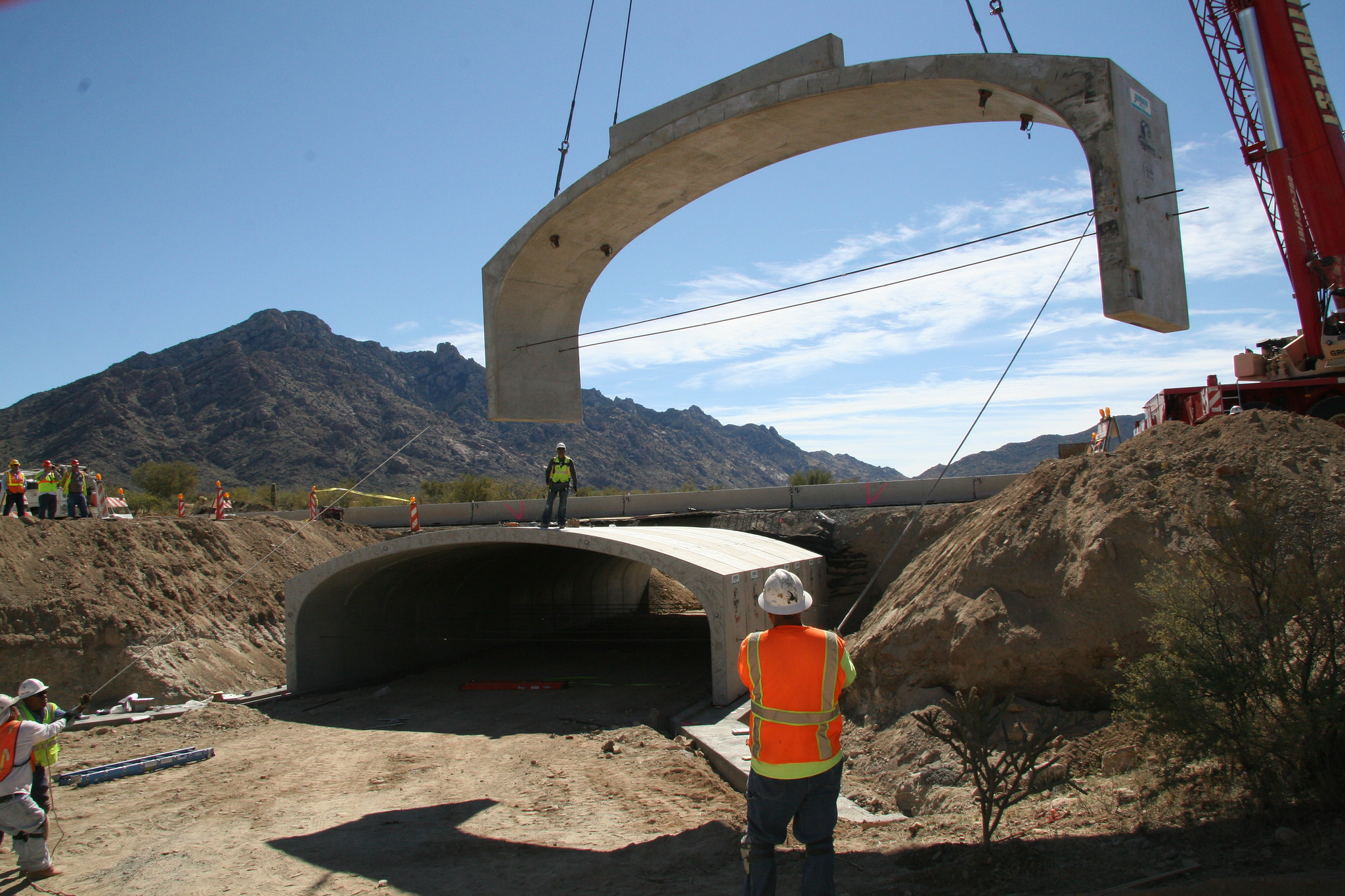
Wildlife underpass being constructed in Arizona. Photo credit Arizona Department of Transportation, Flickr, CC BY-NC-ND 2.0
Another issue having to do with the parks and corridors is “multi-use.” “Multi-use,” “land of many uses,” sounds good, but it’s not working out very well. What multi-use does is cover a conflict of various uses. One use is to protect the animals, [and maintain] clean water and clean air. That’s the environmental aspect. Another use is to provide recreational opportunities for people. Skiing, hiking, horseback riding, biking, sometimes hunting. And the third one is to make some money. Let’s have an addition to our tax base via concession fees, entrance fees, camping fees, all these things.
So you have these three purposes covered by the name “multi-use.” ‘And how do you reconcile the three?’, I hear you ask. Well, you can’t, because they’re all given equal weight. If you read the mission statements of the parks, they’re all given equal weight, there’s no priority. And that means that whatever the administration of the state or federal park [wants], they’re going to change which of those three have priority, and so it’s a shifting alliance. So what we need to do – what somebody in this audience will do, I hope – is to try to get a priority, a purpose, for the parks along the wildways.
I understand that in New York City you may have a different set of parks, and you may have a different set of purposes. Maybe they’re more geared toward the people in New York. I would think so. But when you’re out in the mountains you need to have the priority for the environmental purpose. That still needs to be done, and has not been done.
The last thing I want to mention about the parks and the wildways is this: National parks are designated by Congress. National monuments are designated by the President. This has proven to be very important because, in the waning years of his presidency, President Obama was able to designate a whole bunch of national monuments, which are under attack now by the way. They’re trying to un-designate them. We’ll see if that’s even legal.
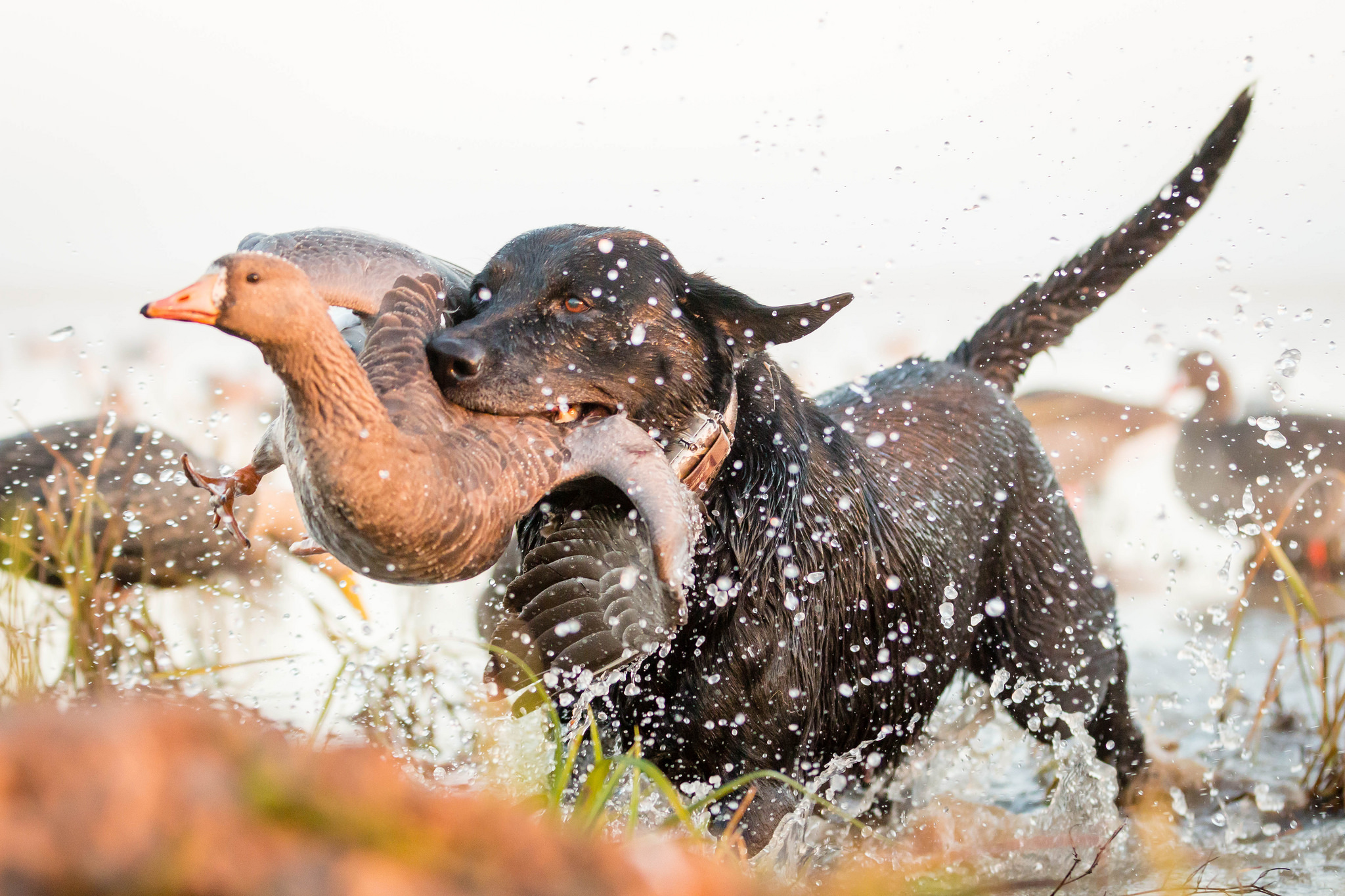
Hunting dog capturing a goose. Photo credit Matthew Stagner, Flickr, CC BY-NC-ND 2.0
Hunting and Trapping
The next issue is hunting and trapping. Hunting policy is the province of the states, unless it’s on federal land, and every state has a commission or agency that sets hunting policy. These commissions are heavily weighted toward hunters, fisher people, and ranchers. They’re prisoners of the past. I’ll give you an example: Colorado Parks and Wildlife (CPW) has an eleven person voting commission. Of those eleven people, six by law are ranchers and hunters. That doesn’t reflect current demographics at all! But what it means is that everything you bring to these commissions of an environmental sense is going to get voted down. This is the case in most federal and state commissions, they’re heavily weighted toward hunters and ranchers, and this needs to change too. Which means we need to go to these meetings. These are public meetings that the commissions have, so we can go and speak, but they have them in out-of-the-way places and they do that on purpose to keep city people from going there and making their wishes known.
I went to a meeting a while back. There were just three of us, and we were the only three environmentalists. There were a ton of hunters, and there were a ton of agency people, and just us. But we got up and spoke, and when I got up and said that I was representing Vegan Life Colorado, that was a big hit I can tell you. But we have to go to these meetings – otherwise the policy is never going to change. But going back to the commissions, if you want to do one thing to help wildlife, change the composition of these commissions that exist in every state.
Trapping is the same thing. Their policies are set by the same commissions as hunting policies. We thought when I was doing this work back in the 80s and 90s that we had the fur issue under control, that it was not cool to wear fur anymore. But we were wrong. It’s coming back. So we have to go to those meetings, and we have to make our voices known. The people who don’t wear fur, the people who don’t want to shoot animals, we’re an increasing demographic, but we’re not represented where we need to be represented in order to make policy.
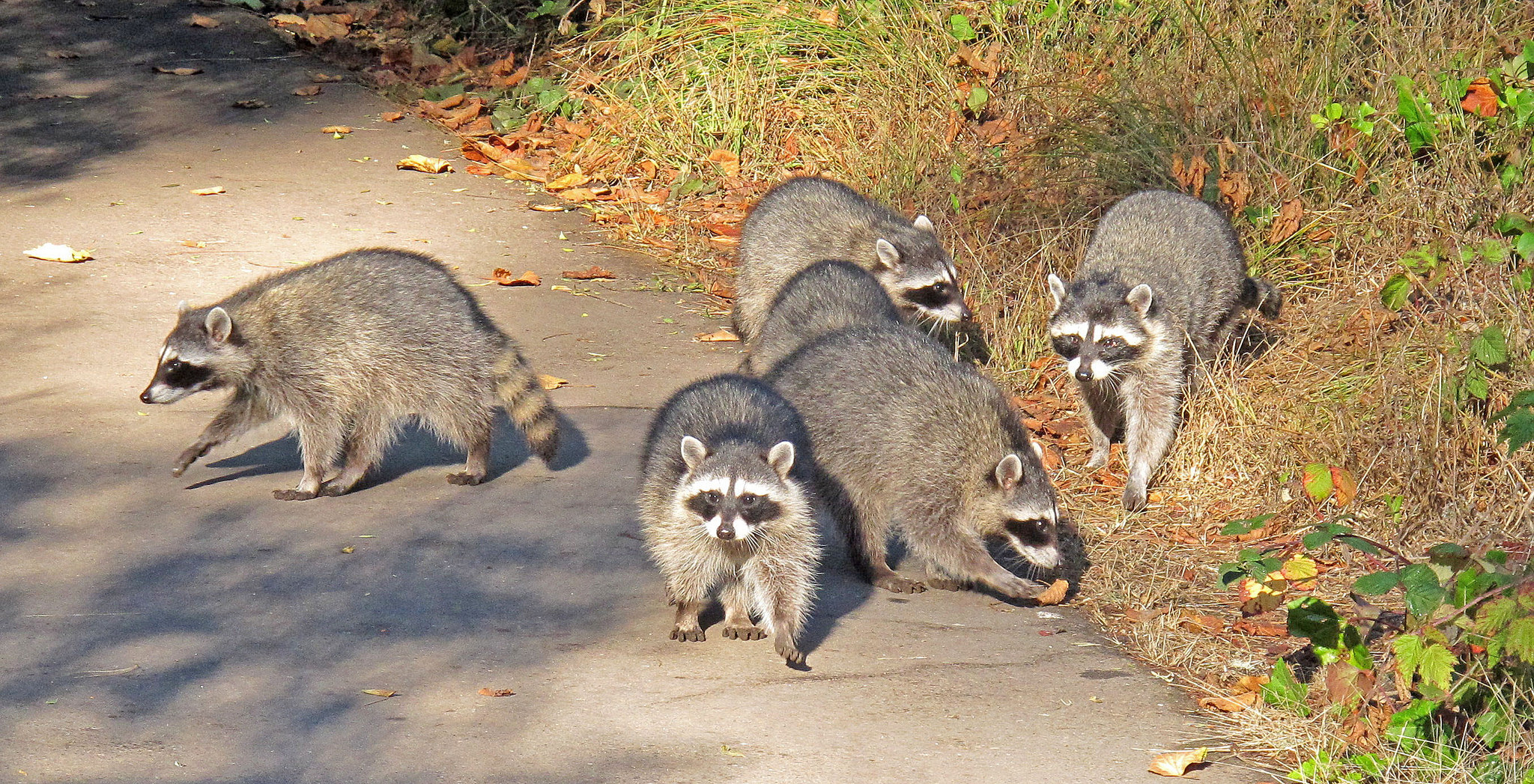
Raccoons in San Francisco. Photo credit Ken Schneider, Flickr, CC BY-NC 2.0
Urban Wildlife and Reconciliation Ecology
Let’s go on to urban animals now. I myself have seen foxes and coyotes in Denver. Raccoons come into our backyard – you always know they’re there because the neighborhood dogs go crazy. But there are a ton of animals: deer, bears up in Boulder, they come into the cities now. So what are we going to do to make the cities more friendly for animals? I mentioned connectivity in the context of the wildways, but connectivity is equally important in the cities, because the animals live in the parks, and how do they get from one park to the next without getting run over on Colfax Avenue? It’s impossible for them to move around, to find mates, to find new feeding grounds. We have to adjust our notion of what cities should be.
There are three ways by which the animals get from park to park. Number one: railroad tracks. Don’t tear down the railroad tracks. Whether they’re used or not, they cut through the neighborhoods, and the animals use them. There was a study done on coywolves in Canada – you might not know what a coywolf is, but it’s a combination between a coyote and a wolf, beautiful animal – and in Toronto, it was found that they use the railroad tracks. That’s how they get around Toronto, and that’s how they get around the other Canadian cities.
So keep the tracks. Or [secondly] you can turn them into biking trails, that’s fine too. Anything that cuts through the neighborhoods is fine, put some foliage along the side and you’re in business. The third way animals get around is by above-ground streams. Most of the streams in cities were put underground in the last century. They’re in drainage systems, they’re in culverts, they’re in pipes underground, and oftentimes the old streambeds were covered. But the animals need those to get around. Think about it, they want to get from park to park. Now what makes a park? A lot of trees. And that meant the trees had water. So the streams were going from park to park, essentially, back when they were above ground. If we restored those streambeds, the animals would have safe passage. The whole process of restoring streambeds is called “daylighting.”
I think this is a good time to talk about reconciliation ecology. I don’t know if you know that term, reconciliation ecology, but it’s an important term. It’s a new branch of environmentalism. Traditionally, environmentalism meant saving wild places, saving species, clean air, clean water. Don’t let people screw everything up. And that’s still the heart of the thing, but what reconciliation ecology does is it takes human dominated environments and makes them more friendly to animals and plants and all other forms of life.

Heron at the edge of an urban garden. Photo credit Urban Simba, Flickr, CC BY-NC-ND 2.0
I’ll give you some examples. When we go to the big cities and we see all these giant buildings made out of glass and steel, the sun reflects off them and bakes the people down below. Well what if there were solar collectors situated between these large buildings to pick up the sunlight? What if there were community gardens situated between the large buildings to give the tomatoes and the corn what they need in terms of heat? Cities aren’t built like that, but they could be, and reconciliation ecology is about that. It’s about rooftop gardens – give tax credits for rooftop gardens, because it would solve a whole host of problems. You’d have cleaner air, you’d have beauty, you’d have habitat for animals, people would have vegetables to eat, you’d cut health costs. But again, this has to be done in advance with city planning, as opposed to always playing defense.
So we can do this. And the thing about reconciliation ecology is, it’s optimistic. Doing the work we do with animal rights, there’s a lot of suffering. But what reconciliation ecology says is, we’re actually part of the ecosystem, and if we can use our technology and preplanning to make things better, why not? And that gets us out of a very pessimistic place, so that we don’t get caught up in the suffering. If we’re caught in the suffering, that takes us down, that takes our message down. So this is a way out. It’s a way out that works for me, anyway, to think that people can actually make this a better planet. It can be done.
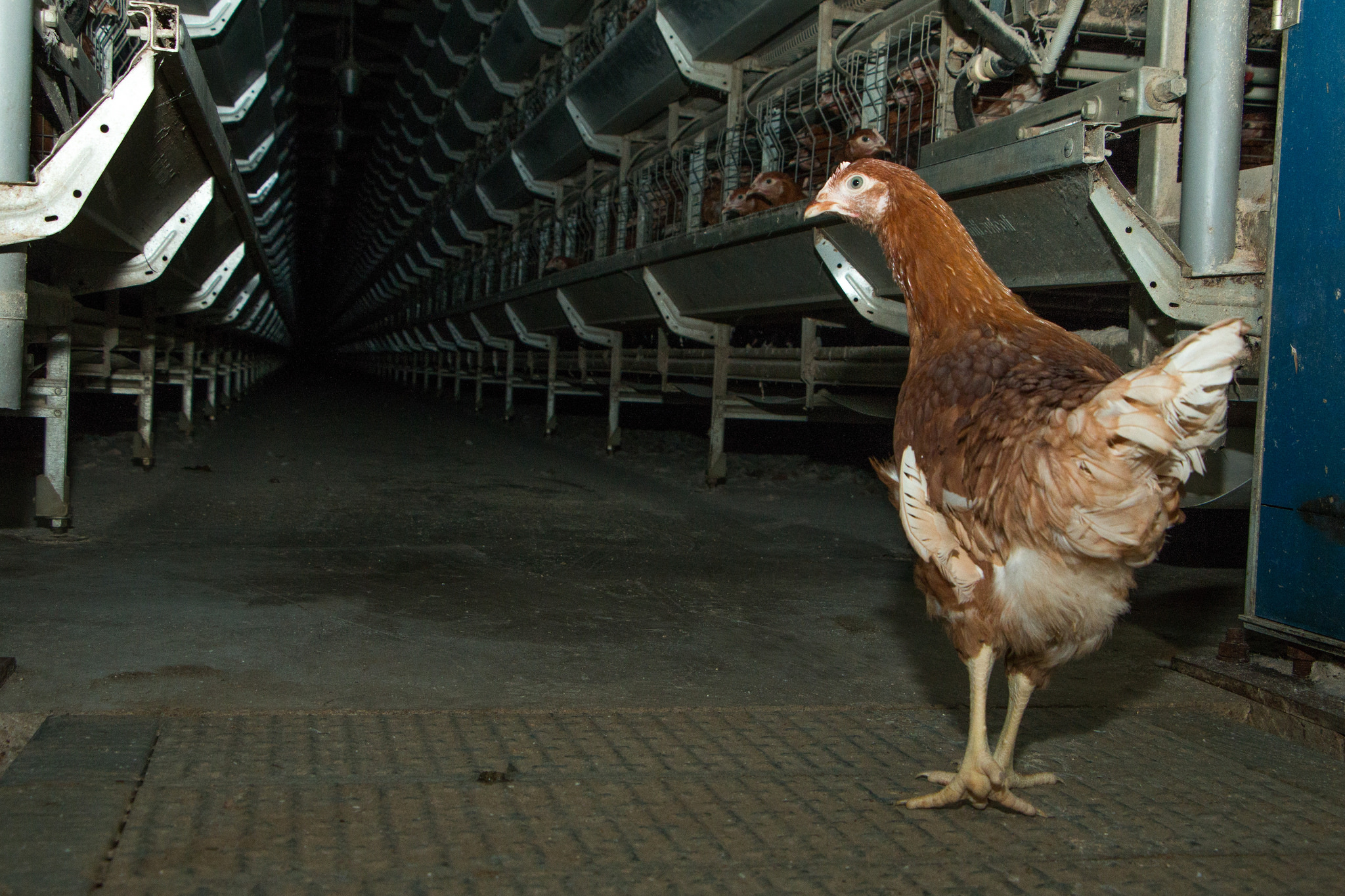
An escaped laying hen walks down an aisle of cages in a Balticovo egg farm in Latvia. Photo credit Dzivnieku briviba, Flickr, CC BY-NC 2.0
Factory Farming and the Power of Cities
One place we could use optimism is in the factory farms. They’re also known as CAFOs, standing for Concentrated Animal Feeding Operations. They call them that within the industry – we call them factory farms. That’s where most of the suffering is. It saddens me when I go to most of these legislative meetings and the legislators are always hot to make dog and cat bills. They want to make things better for dogs and cats. Fine, I love it, but they’re afraid to take on the farm lobby. The farm lobby is extremely powerful. They’re right up there with the NRA. And that is the case both at the federal and the state level, very seldom will they take on the farm lobby. So we’re going to have to get it done in the cities. And this is the most important thing I’m going to tell you today: the cities are our way out of this. That is where we’re going to get progressive legislation.
And it’s already happening. Who is at the forefront of the sanctuary movement? The cities. Who is at the forefront of the climate movement? The cities. After Trump pulled out of the Paris Accord, over a hundred cities wrote to the Europeans saying, ‘hey, we’re in!’ And they have passed humane legislation too in the cities. Here’s an example: New York passed a law saying that no more circuses with exotic animals will be allowed in New York City. Other cities have done this too. Why do you think Ringling Brothers went out of business? It’s partially because of changing attitudes regarding animals, but another reason is that these exploitative industries can’t survive without city support. That’s where the big money is. So if you’re going to do legislation, go out and start in the cities.
So how do you get legislation passed in the cities? There are only two rules for successfully passing legislation. Unfortunately, nobody knows what they are. The way I would do it, is I would go to a town that I knew would pass something experimental. In California it was Berkeley and Sebastopol, two very environmental areas. Get something passed there, and then the other cities will look and see it’s not the end of the world! And in a year they pass it too, and then you take it to San Francisco or Los Angeles, and then you take it to the state. But start out with a city that will try something new.
When it comes to meat, the cities can do it too, because there are no farms or ranches within city limits. So they’re not afraid of the farm lobby. So you see, that makes a big difference, that’s how it’s different from the federal and the state levels, they’re not afraid of the farm lobby because the farm lobby doesn’t exist in the cities. Plus the voters there tend to be more progressive. So you put those two factors together and you have the opportunity for cities passing something really meaningful.
Here’s how they can do it: they can do it from the purchase end, not from the production end. It wouldn’t make any sense for the cities to say, for example, you can’t use antibiotics raising animals, because there are no farms or ranches within the city limits. But they can say ‘we won’t buy it.’ That’s the purchase end, and that’s what we can do on so many things, go from the purchase end in the cities.

Vulture scavenging a dead pig discarded from a factory farm in North Carolina. Photo credit Waterkeeper Alliance Inc., Flickr, CC BY-NC-ND 2.0
I just mentioned antibiotics, but I want to say that for me this is a key issue. Antibiotics are the Band-Aids that cover the abuses of factory farms. Without the addition of antibiotics in all the animals’ food and drink, the animals would die. They [agribusiness] would have no business, and therefore if we say no antibiotics their choice is either to go out of business or to give the animals better conditions. So it’s a win-win. It’s a win for the animals because they’ll get better conditions since, if they don’t, they’ll die without antibiotics. And it’s a win for people because we’ll keep the use of antibiotics for ourselves, and for the animals too when they actually need it.
The medical community is freaking out over the loss in the effectiveness of antibiotics. What happens is that people buy the meat, the meat is filled with antibiotics because it’s added routinely in the feeding of animals, people ingest it, and the bacteria develop very quickly that become resistant to it. We’re losing antibiotics’ [effectiveness], and if we jump all over this, we have allies we usually do not. The AMA, the World Health Organization, they would be our allies. This is a chance to build a bridge. So what I’m saying is, if you want to take one issue to your city council, make it antibiotics. It’s a win-win. And a lot of restaurant chains, like Subway, advertise very prominently “no antibiotics,” so it’s a winner for them too.
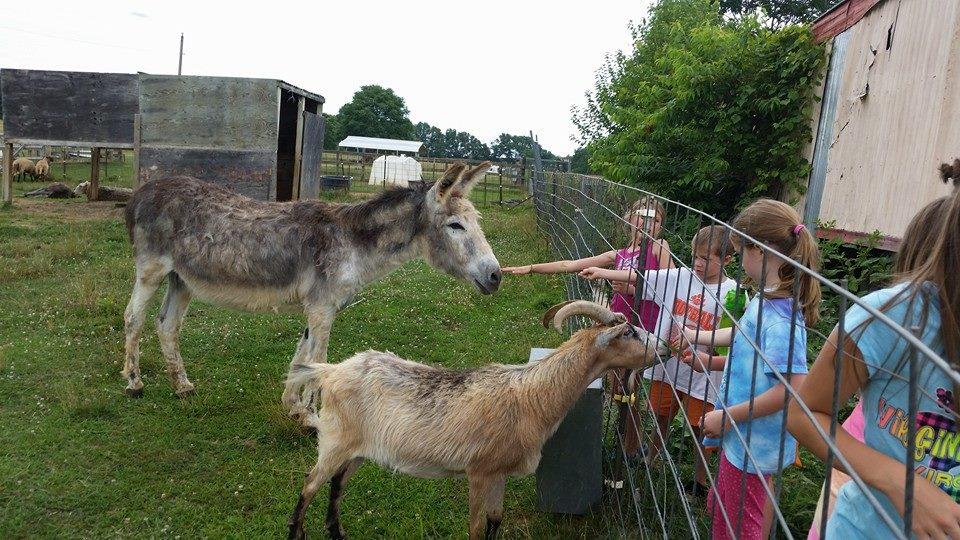
Girl scouts interact with donkey and goat at Rikki’s Refuge animal sanctuary. Photo credit Rikki’s Refuge, Flickr, CC BY 2.0
Humane Education
The next subject I will address is education. You’re not going to get city councils that are worth anything if you don’t have an educated electorate. Education has to start at a very early age. I’ve been doing animal rights work and environmental work for thirty years now, and these movements are mainly comprised of women. We’ve got to get young boys in the primary grades interested [too]. They like superheroes – let’s bring back the Green Man. It’s a natural. The Green Man was this leafy being, half tree half person, who is in service to Mother Earth. He’s a very big figure in shamanistic cultures. And in the primary schools, let’s teach basic things about the benefits of veganism. Let’s teach about the link between animal abuse and domestic abuse. The link between what we eat and what’s happening to our climate. These are all things that can be taught in the primary grades. They’re all provable things, they’re not particularly speculative.
This goes up through the college level also. What would be different at the college level if we had a humane culture? Right now we have a lot of good degrees in wildlife management, wildlife biology, protection of species, reforestation. There’s even a Wilderness Institute at the University of Montana. Great stuff. But where are the degrees and the courses of study that teach reconciliation ecology? Where’s the degree that teaches rooftop gardens, drainage systems in rooftop gardens? Where’s the degree on how to build tensile strength into the overpasses so that we can put vegetation on them so animals will use them? All the things I talked about before? These degrees don’t exist, and they need to. So at the college level, that would be a whole different thing to have those available and funded – and I’ll get to the funding part later.
I think I’ll talk about law schools now. I know there are attorneys in the audience, but I don’t know if there are any law students. What would be different in law school if this was a humane culture? First of all, there would be more courses in animal law. There are already more than 120 schools that teach animal law and this is due to the hard work of the Animal Legal Defense Fund. They put these [courses] together, they promote them, they make them possible. They pass out the curricula so you don’t have to reinvent the wheel. So if any of you are thinking of going to law school and wondering where these courses exist, there will be a link to it in the handout. There’s a handout as you go out the door, and that’s one of the links.
The second thing we would have to do in law school that they’re not doing now is to teach more about regulatory law. It’s a common misapprehension that the law affecting animals comes from legislatures. It doesn’t. They set broad policies, but the nuts and bolts are done by agencies: the FDA, Fish and Wildlife, the Colorado and various other commissions. There are a bunch of commissions.
So we need to know how to navigate the field of regulatory law. When I was in law school, there was this obscure course called Administrative Law that nobody took. But people have to take it, because if we’re going to change things for animals we have to know these agencies – who’s on the board, how do you get on the board, what are their timelines, what are their notice requirements? Those things are not generally known by attorneys, because they’re not commonly taught. So that would change in the law schools.

Dog and baby sleeping together. Photo courtesy Kim Bartlett / Animal People, Inc.
Animal Law
Speaking of law schools, and switching to law itself, what are some of the big things coming up in the next twenty years? First of all, animals are still property. That is the biggest issue, that is the basis of their exploitation. So we need always to work on that. I’ll give you an example. I used to do a lot of divorce cases, and in divorce cases, there is often an animal. A decision has to be made about who gets the animal, who gets custody. Those decisions were always made on property concepts: who bought the animal? Who pays the vet bills?
Are those really the things we should consider? Shouldn’t we be talking about who the animal likes the most? Who spends the most time with the animal? That’s how it should be. But that’s only a factor in one state – the other forty-nine states don’t even consider the best interests of the animal. One state, Alaska, has included that in its long list as one factor to be considered. But it should be the main factor, like it is for children. They don’t ask who owns the child, they ask where the child is happiest, who’s put in the time, who’s put in the love, who’s put in the care. It should be that way, and the model’s right there in the domestic courts. If they want to switch it over to animals, it’s right there.
Another issue has to do with standing. In legal terms, standing means you have the right to come into the court and present your case because you have a grievance that we are allowed to hear. Animals, as property, do not have standing, and people who try to come in and litigate for animals are told they don’t have standing either. Why? Because the injury’s not to you, it’s to the chimpanzee. [The courts ask] Who injured you, what are you doing in court? So this is the great paradox that Steve Wise has been working on for years: those with injuries have no rights, and those with rights have no injuries. So out you go, you get thrown out of court. One state, Pennsylvania, has given standing to SPCAs to initiate cruelty cases. But the other forty-nine have not, so if you live in one of those forty-nine states, look at the Pennsylvania statute and see if you can get it done in your state. It’s really easy to do, and it gets out of this whole unfortunate issue.
Another issue that I think is important: Registries. It’s essential that somewhere along the line we get registries for felony animal abusers. We tried, and they shot us down in Colorado. In no state, as far as I know, has a registry been erected. A couple of counties, a couple of cities have done it, but no states. And you ask yourself why? You’d think everybody would want to know who the animal abusers are.
The answer lies in the states’ experiences with the sexual offender registries. There have been a lot of unintended consequences and all the states are very wary about setting up another registry. So it would have to be very tightly worded, and it would cover only the most serious crimes. But it’s necessary, because if somebody goes in to adopt at a shelter, you want to know right away if this person is likely to be an abuser because they were a felony abuser. And if the person at the front desk has to spend twenty minutes paging through some obscure table to find that out, they’re not going to do it. So it has to be something that’s immediately accessible. This is something I wish somebody in this audience would grab too, because we need some public outpouring of support next time we go up and ask for a registry, as we’re going to.
The last part of the law issue I want to bring up is this: language. Language creates reality. When I would go into court I would always talk about “companion animals,” and back in the 80s and 90s this was brand new. But we can do that in our lives now. When you’re talking to your friends, say “companion animals,” not “pets.” Talk about “custody,” not “ownership.” Say “hey, you’re eating a cow” – it’s not “beef.” When you’re talking about a pig, mention “pig,” a wonderful and intelligent animal, not “pork.” When we do this with our friends and family it is very difficult sometimes, as I have experienced. But I think we need to do that anyway. That’s part of our job, to bring consciousness.

2016 rafting trip organized by Jane Goodall Institute Nepal to raise funds for river dolphin conservation. Photo courtesy Wolf Gordon Clifton / Animal People, Inc.
Humane Economy
The last major area I’m going to discuss is the “Humane Economy.” How do you create a humane economy? How do you make compassion profitable? Let’s start out talking about ecotourism. Big business in Belize, Nepal, Brazil. It’s enormous, and it’s a great thing . . . when it’s real. But there’s a lot of greenwashing in ecotourism business. You’re probably familiar with the term, but if you’re not, “greenwashing” means presenting something as environmentally friendly when it really isn’t. True ecotourism has respect for the local cultures. It has respect for the environment. You don’t bring bulldozers in to put roads into roadless areas, you don’t try to overwhelm the local culture with a giant hotel, or build an underwater hotel in a fragile reef system. That’s not ecotourism.
So we need some regulation of that. Governments generally don’t want to regulate it because they like money. The tourists come, you can call it ecotourism, you can call it anything you want, it’s green – as in the color of money green. Governments are not about to be serious about regulating ecotourism, so a lot of this will have to be private. Costa Rica does have a zero to five rating system for any ecotourism ventures within their country. The University of Oregon has a greenwashing index.
Government does have a part in all of this. China has recently said they’re going to ban the ivory trade, and if they actually do that it would be huge because China and southeast Asia are the main destinations for ivory. It’s considered a sign of prosperity and long life, but not for the elephants. So if China goes ahead and enforces that, that would be great. Other governments are also doing some great stuff. Look at the island nation of Palau. Its territorial waters are all shark protected – you can’t fish for sharks in their waters. Indonesia has done the same for manta rays.
So some governments are doing something. But I think we’re going to have to enlist the private sector here, and the airlines. The airlines have stepped up quite a bit actually. Air France and South African Airways are no longer shipping the products of trophy hunts. As the other airways see that this works, that it gains them business, they’ll join in. And if trophy hunters can’t ship it back, why would they shoot the animal? So this is going to help the animals. Transportation is the Achilles heel of these exploitive industries. If they can’t get their ill-gotten product from A to B, they’re not going to seek it. So keep working on the transportation industries. The airlines, the shipping lines, that’s where we can make our voices heard. You pick one link in the chain, and you go for that. That’s the weak link.
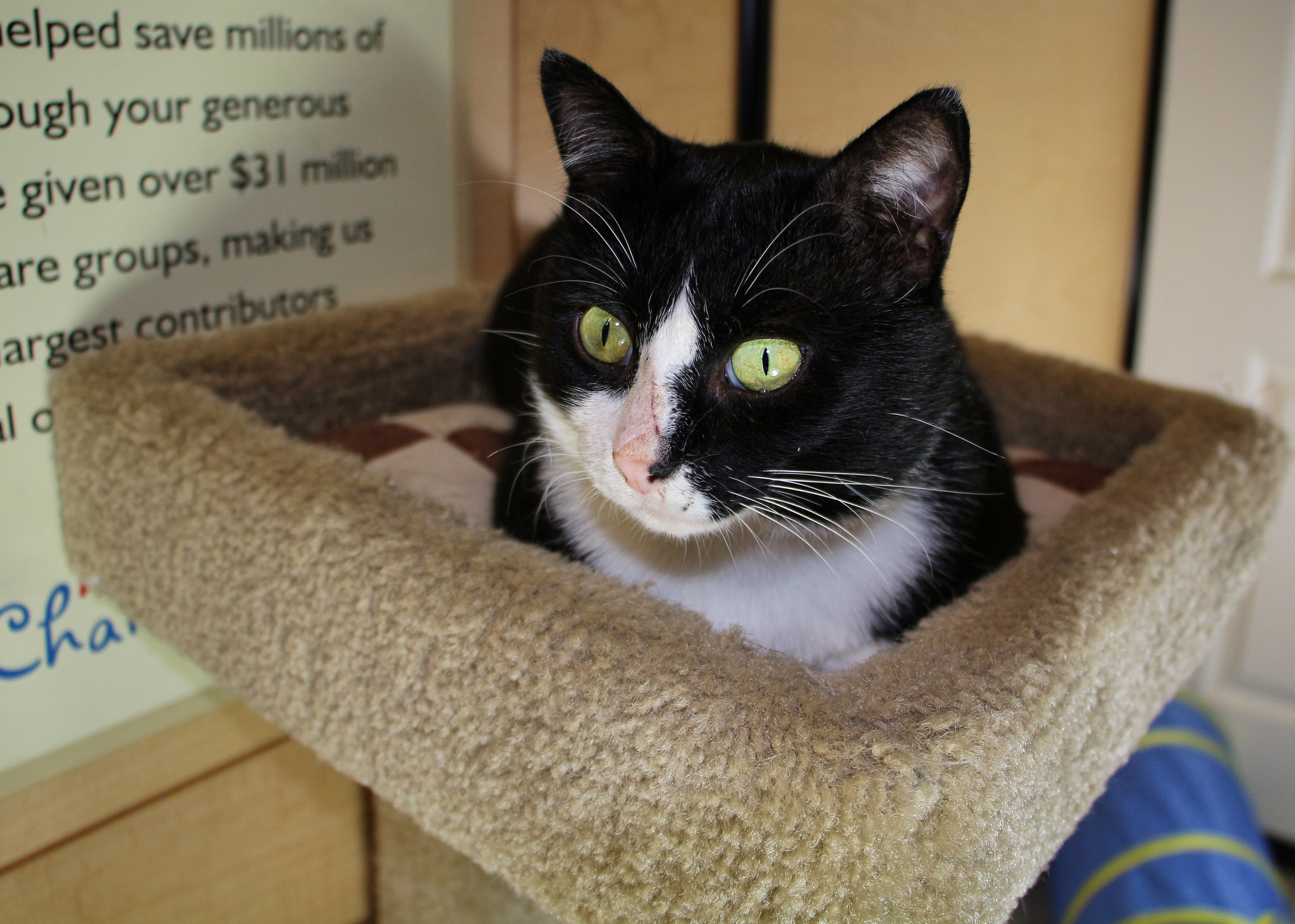
Cat awaiting adoption at PetsMart store. Photo credit Kyla Duhamel, Flickr, CC BY 2.0
There have been other businesses that have stepped up too. PetCo and PetsMart, they don’t sell puppy mill animals. They only do SPCA animals. And I [already] mentioned Subway and how they’re not going to do antibiotics. So the private sector is doing a lot of stuff. But the main thing, in my opinion, that the private sector can do is tell the backstory. This has to do with meat particularly. What is the backstory of this meat?
We as vegans, or almost vegans, want to know: is this local? Is this organic? These are the kinds of questions we ask when we go to the market. Well, carnivores ask questions too: was this animal raised with antibiotics? Was this grass-fed or feedlot? What were the conditions there? So any market that wants to be conscious and makes the backstory known is doing a huge thing. And anyone who invents an app that will send you all that information as you’re standing in the aisle – great business, great help to the animals too.
The last thing I want to talk about in terms of the humane economy is the place of NGOs, non-governmental organizations. They have a big part to play in this. NGOs can run sanctuaries that the volunteers go to. I talked about the Humane Economy – sometimes volunteers go to sanctuaries that are actually zoos, they advertise as these great sanctuaries but they’re zoos. But if they were run by the NGOs, I think they would do better than the for-profit organizations that often run them now. The NGOs can be the recipients of [legal] standing, as I mentioned – [hopefully soon] in more than one state. And lastly, the NGOs need to stop fighting with each other. I’ve been in this a long time, and they’re fighting for donors, and they have secret information from each other – it’s pretty bad. But there are some issues where the NGOs are coming together. One is the corridors, trying to build these wildways. There are a number of groups that are sharing information, working in concert. There’s even one here in Denver, Rocky Mountain Wild.
Another way NGOs are cooperating is in the costs for ag-gag cases. Now let me explain what ag-gag is because it won’t make any sense to talk about the costs if you don’t know what it is. Ag-gag refers to the laws in a number of agricultural states that penalize criminally the taking of undercover videos. The factory farms and the slaughterhouses are scared to death of undercover videos, and that’s why they passed these laws. Now on two occasions already these laws have been declared unconstitutional, and NGOs got together to do that. There were several that pooled their money, pooled their resources, and they defeated these ag-gag laws on First Amendment grounds, which is great. So the NGOs can do a lot.
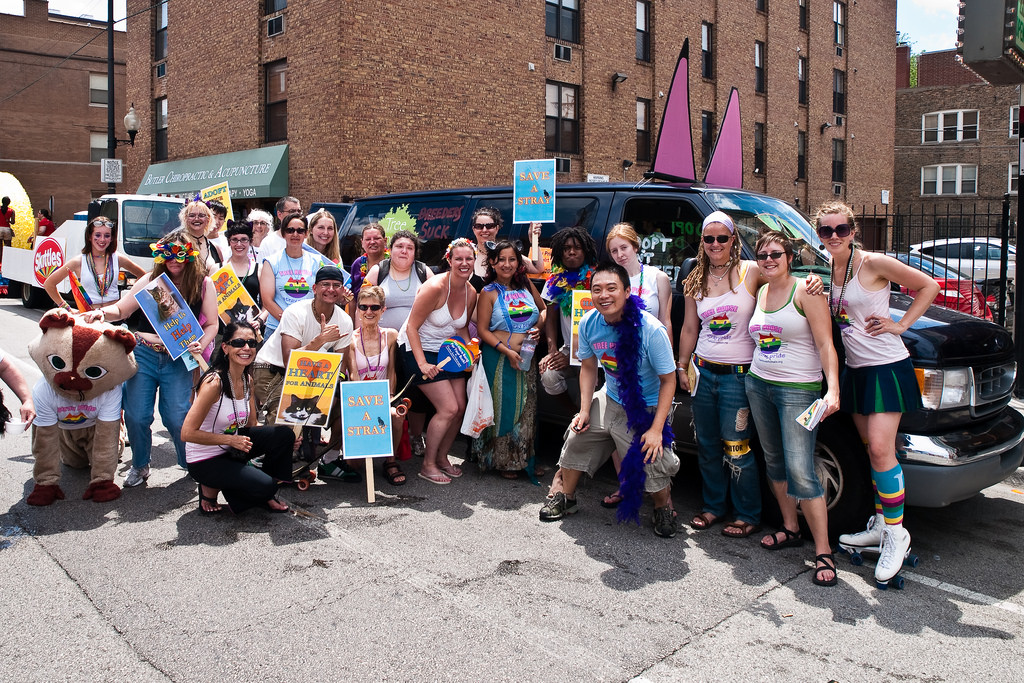
Animal advocates from Tree House Humane Society at a LGBTQIA pride march in Chicago. Photo credit Alan C., Flickr, CC BY-NC-ND 2.0
Other Issues
I’ll cover the other issues quickly. First of all, the animal rights movement needs to join forces with other social justice movements. We are a social justice movement with a long, proud history. But we haven’t joined forces. We have a long link with feminism. But what about Native American [issues]? Was there an animal rights presence at Standing Rock? We missed an opportunity. There were environmentalists there, saying, ‘Listen – Native American rights and clean water, same thing.’ And we have an opportunity to do that now, with the grizzly bears in Yellowstone. There’s a movement afoot to delist them from Endangered Species Act protection, which means people can hunt them again. Several Native tribes in the area have already said ‘No, this is cultural genocide.’ And it is, and we should be there, because they strengthen us and we strengthen them. It’s all part of the same tree of dominance, and the quicker that we realize that and lend our support, and receive that kind of support, the stronger we will be.
Let me talk about native and non-native too. The distinction between native and non-native has long been crucial in setting any wildlife policy. But that’s shifting. Because of climate change, animals are moving, and what was non-native ten years ago will soon be native. So all those definitions are going to have to be reworked. President Obama, in one of his last moves, made a rule saying that any decision involving invasive species must take into account climate change. So that’s a really important thing to do.
Here’s another one. This is a big one, it’s always lurking at the bottom of the pool. Human overpopulation. I spoke about that last year in my talk, so I’m not going to go into a whole tirade again, but I’ll just say this: Everything that we do in terms of veganism, carbon credits, electric cars, is going to get swallowed up if the human population continues to grow at its present rate. That’s just the sad fact. There will be more people, more transportation, less habitat, more people eating meat. If we don’t get that under control, I don’t know how we’re going to win this, to tell the truth. That is the bottom line issue.
I need to mention veganism here too because veganism is a bottom line issue. I’m not going to talk about it at any length, because there are people in this building, there are people in this hall, that know more about it than I do. But it’s something we can all do. We can all do this. It doesn’t take a court victory, it doesn’t take an act of Congress, it doesn’t take a lot of money. It’s something we can all do. So please, go vegan, if you’re not already, go vegan.
This is incredible. I’m looking out and I’m seventy-five and I don’t take this for granted. So thank you for being here, for spending your Sunday with me, and for everything you do for the animals. Thank you.

Featured image: pronghorn antelope in Colorado. Credit Ben Simo, CC BY-NC 2.0 / cropped

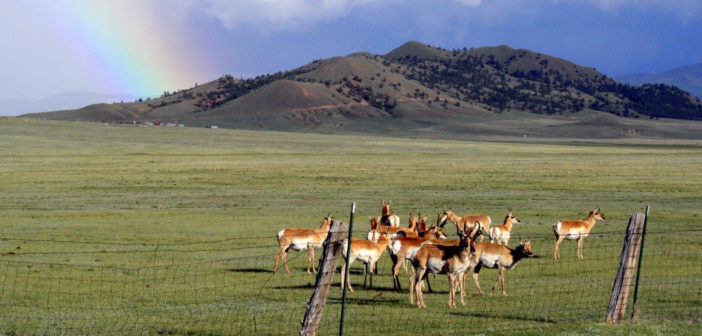




1 Comment
Tunza Games: A place where people save the wild animals. Click https://www.tunzagames.com/conservation-crisis-the-game to learn more.